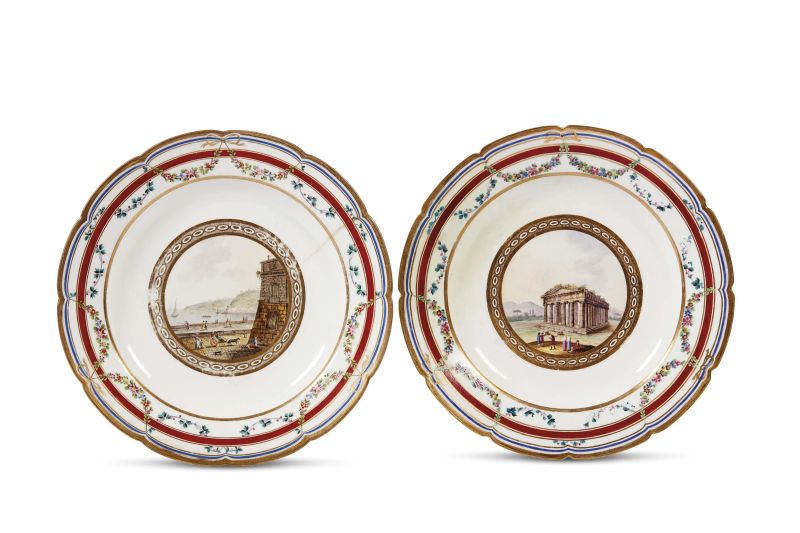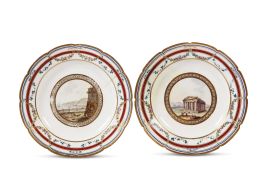AN ASSORTMENT OF PLATES FROM THE ‘VEDUTE DEL REGNO’ (VIEWS OF THE KINGDOM) PRESENTATION SERVICE, OTHERWISE KNOWN AS THE ‘SERVIZIO DELL’OCA’. NAPLES, REAL FABBRICA FERDINANDEA, 1793-1795
a serving plate decorated with a Veduta delle Coste di Pozzuoli (View of the Pozzuoli Coasts). On the reverse, the title painted in red over the glaze and the crowned ‘N’ mark under the glaze. Diameter: 42 cm.
Two serving plates, one decorated with a view of the Monistero de Certosini e Castello di S. Elmo (Carthusian Monastery and Castel Sant’Elmo); the other with a Veduta della Villa Reale (View of Villa Reale). Both carry, on the reverse, the title painted in red over the glaze and the crowned ‘N’ mark under the glaze. Diameter: 30.2 cm.
Four dinner plates with views of: Golfo di Mesina (Gulf of Messina) titled in red over the glaze, without mark; Strada che conduce a Ponti – Rossi, (Road to Ponti-Rossi) titled in red over the glaze and marked with the crowned ‘N’ and a cross etched in the paste under the glaze; Tempio di Pesto (Temple of Paestum) titled in red over the glaze and marked with the crowned ‘N’ under the glaze; Veduta della Costa di Posillipo (View of the Posillipo Coast) titled in red over the glaze and marked with the crowned ‘N’ under the glaze on the reverse. Diameter: cm 24.
The decorations of this assortment of porcelain plates includes panoramic views enclosed within a central medallion and surrounded, on the lip, by flowered garlands and blue and red fillet borders extending to the rim. The porcelain is soft-paste and shows some imperfections and signs of wear: crackling, chipping and hairline cracks. The gold is not always in a perfect state of conservation on all the pieces, although the clarity of the views at the centres of the compositions is unaltered. Of note certain details visible in the secondary decoration, introduced during manufacture, such as the lack of several berries in the garland on the Veduta del Golfo di Messina (View of the Gulf of Messina) plate, on which, additionally, the principal view is out of alignment with respect to the titling on the reverse.
The Servizio delle Vedute del Regno is considered the maximum expression of the veduta genre of late 18th-century Bourbon court production. The service was erroneously assigned the title of Servizio dell’Oca (Goose Service); the denomination derives from the form of the handles of the covers of several soup tureens which show a child strangling a goose (see fig. 1). The image with the Fanciullo che scherza con un cigno (Child Playing with a Swan) is, in actuality, accompanied on other covers by the Allegoria del Tempo (Allegory of Time) showing a child covering his face with his hands and an image of Silenus. Both these figurines are inspired by Roman copies of Hellenistic statues today in the Musei Capitolini in Rome.
Each piece is decorated with a different view of the Kingdom of Naples: the monuments, the archaeological sites and the natural beauties of its territory, from Abruzzo to Sicily, are painted with exceptional pictorial and miniaturistic expertise. The intention is clearly propagandistic; that is, to lay out all the magnificence of the Kingdom before the eyes of guests of the court.
The single pieces making up the table service, when marked, carry a crowned letter ‘N’ in blue.
The majority of the pieces in the service is today conserved at the Museo di Capodimonte (see fig. 2), while only a very few of its pieces remain in private hands (1).
In a systematic study of court documentation, Angela Caròla Perrotti (2) reconstructs the history of this order as it emerges from the extensive correspondence that passed between the ‘Vedore del Reale Ramaglietto’, Luigi Perschie, on behalf of Ferdinand I of Bourbon (as Ferdinando IV of Naples) (1751-1825), King of the Two Sicilies and later of Spain, and the Chief House Steward, Prince of Belmonte Antonio Pignatelli. From their exchanges, we gather that as late as 1792, on occasion of banquets, the court requested loans of plates from the Real Fabbrica to replace the existing table service, which by that time was compromised, with missing and damaged pieces (‘. . . Che avanzi dei piatti netti espari e in mal ordine’ ), recalling that for at least four years the king had been demanding that the manufactory supply the court with ‘un servigio completo da servirlo allorchè S.M. pranza in pubblico’ (‘a complete table service for use when His Majesty dines in public’). The letter constitutes an important terminus post quem, setting for the service an initial date of 1793 ca.; the use of the crowned ‘N’ mark in any case denotes a production dating to after the technique of manufacturing soft-paste porcelain wares was perfected (3).
We know of orders placed earlier by the king for several table services in neoclassical style for use as gifts: of particular note, the Servizio Etrusco (Etruscan Service) (1785-87) for King George III, still conserved at Windsor, and the ‘Herculaneum’ service (1782) for Charles III of Bourbon.
The table service now requested of the manufactory differed in style from the prior orders: the neoclassical style, often based on forms and objects of classical antiquity, decidedly goes beyond the rococo of past production; the work that emerged is fine and sophisticated and is clear in its intent to celebrate the splendour of the Kingdom under Ferdinando IV by comparing the riches of his court to those of antiquity. This stance was in full accord with the directives and the artistic imprint which Marchese Domenico Venuti had given to the manufactory and had maintained since his appointment as director in 1779 (4).
The ‘obligatory views’ service (5) designed by Venuti is decorated with detailed views of Naples and the outlying areas of the kingdom, as well as with images of famous archaeological sites such as Herculaneum (1738) and Pompeii (1740), discovered during the reign of Charles III of Bourbon. It takes its cue from several prototypes already prepared for the ‘Farnese Service’ in 1785, even though in that case the views were all inspired by the coeval work of the Abbé de Saint-Non (6).
Most of the miniatures painted on the new service were drawn from etchings by Cardon, by Hamilton and by the Abbé de Saint-Non; others from drawings by Antonio Joli and Philipp Hackert. The painter of most of the miniatures was Giacomo Milani, director of the manufactory’s painting workshop between 1790 and 1797; besides reproducing the landscapes from the cited source materials, he was the author of several original views (7). Beyond these well-known images, there are also many scenes painted from life by the painters Berotti and Santucci during their time working for the Servizio delle Vestiture del Regno.
Also of great importance is the study, again by Angela Caròla-Perrotti, of the extraordinary dessert centrepiece by modeller Filippo Tagliolini, comprising a total of 114 bisque pieces complementing the miniature painting on porcelain. Its layout was highly complex and called for a close-knit dialogue between the beauties shown in the views on the plates and faithful reproductions of ancient statues of philosophers, muses, Olympian deities. However, Angela Caròla-Perrotti argues that it was not conceived specifically for use with the Servizio delle Vedute del Regno but rather for a service ordered earlier as a copy of the ‘Herculaneum Service’ and then cancelled in favour of the new project; she further argues that earlier models were enlarged upon by Tagliolini with new images – thanks in part to the work of the school he had established at the manufactory. Training for the most talented artists included sending them to copy archaeological works even outside of the kingdom; this explains the inclusion of models whose inspiration does not reflect anything in the Bourbon collections, such as the two images of young women applied to soup tureen covers.
Reference Bibliography
A. Caròla Perrotti, La porcellana della Real Fabbrica Ferdinandea. Naples, 1978, pp. 158-160, nos. 135-139.
A. Caròla Perrotti, La porcellana dei Borbone di Napoli. Capodimonte e Real Fabbrica Ferdinandea 1743-1806. Naples, 1986, pp. 440-450, nos. 371-378;
Vedute di Napoli e della Campania nel ‘Servizio dell’Oca’ del Museo di Capodimonte. Naples, 1995.
N. Spinosa (ed.), Museo Nazionale di Capodimonte. Ceramiche. Naples, 2006, pp. 67-70.
A. Caròla-Perrotti, L’arte di imbandire la tavola e ‘il dessert per 60 coverti’ dei Borbone di Napoli. Naples, 2010, p. 97.
1) The bulk of the presentation service is currently preserved at the Museo di Capodimonte under 411 inventory numbers. A soup tureen, a certain number of plates and several large bowl-shaped cups were subtracted from this nucleus and donated to the Museo Artistico Industriale when it was being established. Other items from the service are today at Villa Cagnola in Gazzada Schianno (VA) (L. Melegatti in La collezione Cagnola. Le arti decorative. Varese 1999, p. 308, no. 374. Cited in M.A. Mottola Molfino, L’arte della porcellana in Italia. Vol. II, Busto Arsizio 1977, fig. 280). Several plates recently made their way into the market (Bonhams, London, 6 July 2010, lots 72-75; Bonhams, London, 7 December 2017, lot 90: two plates).
2) A. Caròla Perrotti, La porcellana della Real Fabbrica Ferdinandea. Naples 1978, p. 158.
3) A. Caròla-Perrotti, L’arte di imbandire la tavola e “il dessert per 60 coverti” dei Borbone di Napoli. Naples, 2010, p. 97, note 37.
4) For further information, refer to Vittore Cocchi, Domenico Venuti e le porcellane di Capodimonte, Florence 1982. It must be noted that Domenico Venuti, son of that Marcello Venuti who initiated the excavations at Pompeii during the reign of Charles III of Bourbon, was at the same time director-general of excavations in the kingdom.
5) Defined thus by the manufactory. A. Caròla Perrotti in Nicola Spinosa (ed.), Museo e Gallerie di Capodimonte. Naples 2006, p. 70
6) Abbé de Saint-Non, Le Voyage Pittoresque, 1881-1885
7) A. Caròla Perrotti in Nicola Spinosa (ed.), Museo e Gallerie di Capodimonte, Napoli 2006 p. 70.






















